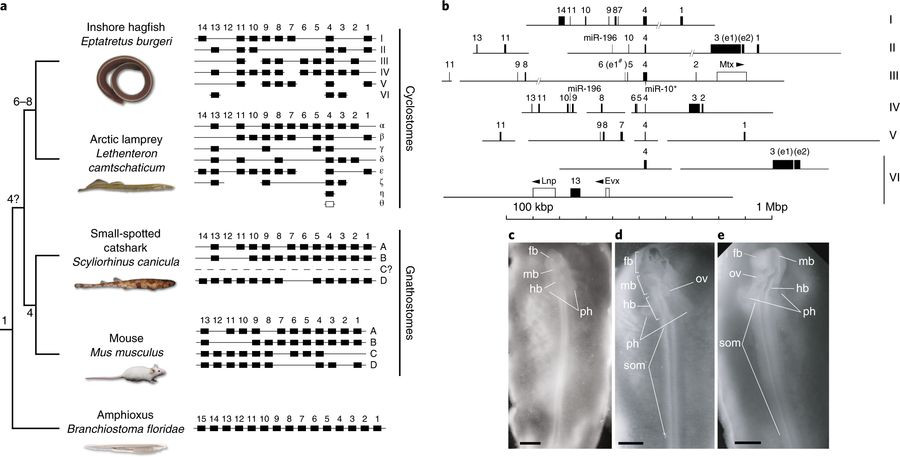ヌタウナギとヤツメウナギのHox遺伝子から脊椎動物における時間的共線性の保存が明らかになる
Hagfish and lamprey Hox genes reveal conservation of temporal colinearity in vertebrates
2018年4月2日 Nature Ecology & Evolution 2 : 5 doi: 10.1038/s41559-018-0526-2

Hox遺伝子群は、動物胚において各領域が主要な体軸に沿って適切に運命指定される際に極めて重要な役割を果たしている。これらの遺伝子は一般に、Hox遺伝子クラスター内のそれぞれの位置に従って限定された空間的領域で発現し(空間的共線性)、これは左右相称動物全体で保存されている特徴である。有顎脊椎動物(顎口類)では、クラスター内の位置によってHox遺伝子の発現開始も決まる(この特徴はクラスター全体の時間的共線性[WTC]として知られる)が、無脊椎動物では、この現象はサブクラスターレベルの時間的共線性として認められる。しかし無顎脊椎動物(円口類)では、Hox遺伝子の発現プロファイルがほとんど分かっておらず、顎口類に見られるWTCの進化的起源はいまだに謎に包まれている。今回我々は、円口類のHox遺伝子が発生中にWTCに従って発現することを示す。脊椎動物の2つの主要分類群に対応する3つの異なる種(ヌタウナギ、ヤツメウナギ、およびサメ)のHoxレパートリーおよびHox遺伝子発現プロファイルを調べた結果、遺伝子がクラスター全体の時差パターンに従って発現していることが明らかになった。これは、無顎脊椎動物と有顎脊椎動物ではゲノムの進化や形態的出力が著しく異なっているにもかかわらず、過去5億年にわたってWTCが保存されてきたことを意味する。
Corresponding Author
Hox genes exert fundamental roles for proper regional specification along the main rostro-caudal axis of animal embryos. They are generally expressed in restricted spatial domains according to their position in the cluster (spatial colinearity)—a feature that is conserved across bilaterians. In jawed vertebrates (gnathostomes), the position in the cluster also determines the onset of expression of Hox genes (a feature known as whole-cluster temporal colinearity (WTC)), while in invertebrates this phenomenon is displayed as a subcluster-level temporal colinearity. However, little is known about the expression profile of Hox genes in jawless vertebrates (cyclostomes); therefore, the evolutionary origin of WTC, as seen in gnathostomes, remains a mystery. Here, we show that Hox genes in cyclostomes are expressed according to WTC during development. We investigated the Hox repertoire and Hox gene expression profiles in three different species—a hagfish, a lamprey and a shark—encompassing the two major groups of vertebrates, and found that these are expressed following a whole-cluster, temporally staggered pattern, indicating that WTC has been conserved during the past 500 million years despite drastically different genome evolution and morphological outputs between jawless and jawed vertebrates.

